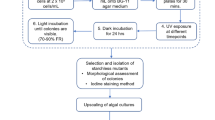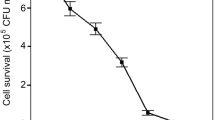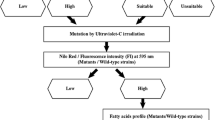Abstract
Because of their high lipid content, microalgae are regarded as a potentially competitive source for biofuels. However, one of the main biotechnological challenges in algae-based biofuels is that cell division is arrested under conditions which promote lipid accumulation, resulting in reduced overall lipid yield. In this study, sethoxydim-resistant mutants of the promising thermotolerant green microalga Micractinium sp., which has a relatively fast growth rate and tolerance to outdoor high temperatures, were generated by UV-C mutagenesis for increased cellular triacylglycerol (TAG) without compromising on growth rate. Two Micractinium mutants were isolated (designated as Mut 3 and Mut 4) that displayed significant increase in TAG cell content up to 71% and 84%, with decreased chlorophyll content by 37% and 38%, respectively, compared with the wild-type cells. Final TAG culture productivity of Mut 3 and Mut 4 were also greater, reaching up to 0.61 ± 0.01 and 0.62 ± 0.02 g L−1, respectively, compared with the wild-type culture of 0.40 ± 0.03 g L−1. The mutants were stable without using antibiotics or any other chemicals during the experiments and preservation. These results highly nominate the mutants of Micractinium sp. isolated in this work as potential microalgae candidates to serve as a feedstock for sustainable and cost-effective biofuel production.




Similar content being viewed by others
References
Abomohra A, Wagner M, El-Sheekh M, Hanelt D (2013) Lipid and total fatty acid productivity in photoautotrophic fresh water microalgae: screening studies towards biodiesel production. J Appl Phycol 25:931–936
Abu-Ghosh S, Fixler D, Dubinsky Z, Iluz D (2015) Energy-input analysis of the life-cycle of microalgal cultivation systems and best scenario for oil-rich biomass production. Appl Energy 154:1082–1088
Abu-Ghosh S, Dubinsky Z, Banet G, Iluz D (2018) Optimizing photon dose and frequency to enhance lipid productivity of thermophilic algae for biofuel production. Bioresour Technol 260:374–379
Adar O, Kaplan-Levy RN, Banet G (2016) High temperature Chlorellaceae (Chlorophyta) strains from the Syrian-African Rift Valley: the effect of salinity and temperature on growth, morphology and sporulation mode. Eur J Phycol 51:1–14
Breuer G, Lamers PP, Martens D, Draaisma RB, Wijffels RH (2012) Triacylglycerol accumulation in microalgae. Bioresour Technol 124:217–226
Burton JD, Gronwald JW, Somers DA, Connelly JA, Gengenbach BG, Wyse DL (1987) Inhibition of plant acetyl-coenzyme A carboxylase by the herbicides sethoxydim and haloxyfop. Biochem Biophys Res Commun 148:1039–1044
Burton JD, Gronwald JW, Somers DA, Gengenbach BG, Wyse DL (1989) Inhibition of corn acetyl-CoA carboxylase by cyclohexanedione and aryloxyphenoxypropionate herbicides. Pestic Biochem Physiol 34:76–85
Chaturvedi R, Fujita Y (2006) Isolation of enhanced eicosapentaenoic acid producing mutants of Nannochloropsis oculata ST-6 using ethyl methane sulfonate induced mutagenesis techniques and their characterization at mRNA transcript level. Phycol Res 54:208–219
Chaturvedi R, Uppalapati SR, Alamsjah MA, Fujita Y (2004) Isolation of quizalofop-resistant mutants of Nannochloropsis oculata (Eustigmatophyceae) with high eicosapentaenoic acid following N-methyl-N-nitrosourea-induced random mutagenesis. J Appl Phycol 16:135–144
Engin IK, Cekmecelioglu D, Yücel AM, Oktem HA (2018) Evaluation of heterotrophic and mixotrophic cultivation of novel Micractinium sp. ME05 on vinasse and its scale up for biodiesel production. Bioresour Technol 251:128–134
Francisco ÉC, Neves DB, Jacob-Lopes E, Franco TT (2010) Microalgae as feedstock for biodiesel production: carbon dioxide sequestration, lipid production and biofuel quality. J Chem Technol Biotechnol 85:395–403
Griffiths MJ, Harrison STL (2009) Lipid productivity as a key characteristic for choosing algal species for biodiesel production. J Appl Phycol 21:493–507
Heath RJ, Rubin JR, Holland DR, Zhang E, Snow ME, Rock CO (1999) Mechanism of triclosan inhibition of bacterial fatty acid synthesis. J Biol Chem 274:11110–11114
Hu Q, Sommerfeld M, Jarvis E, Ghirardi M, Posewitz M, Seibert M, Darzins A (2008) Microalgal triacylglycerols as feedstocks for biofuel production: perspectives and advances. Plant J 54:621–639
Lee B, Choi GG, Choi YE, Sung M, Park MS, Yang JW (2014) Enhancement of lipid productivity by ethyl methane sulfonate-mediated random mutagenesis and proteomic analysis in Chlamydomonas reinhardtii. Korean J Chem Eng 31:1036–1042
Li Y, Horsman M, Wang B, Wu N, Lan CQ (2008) Effects of nitrogen sources on cell growth and lipid accumulation of green alga Neochloris oleoabundans. Appl Microbiol Biotechnol 81:629–636
Liu J, Pei G, Diao J, Chen Z, Liu L, Chen L, Zhang W (2017) Screening and transcriptomic analysis of Crypthecodinium cohnii mutants with high growth and lipid content using the acetyl-CoA carboxylase inhibitor sethoxydim. Appl Microbiol Biotechnol 101:6179–6191
Moha-León JD, Pérez-Legaspi IA, Ortega-Clemente LA, Rubio-Franchini I, Ríos-Leal E (2018) Improving the lipid content of Nannochloropsis oculata by a mutation-selection program using UV radiation and quizalofop. J Appl Phycol 31:191–199
Mokashi K, Shetty V, George SA, Sibi G (2016) Sodium bicarbonate as inorganic carbon source for higher biomass and lipid production integrated carbon capture in Chlorella vulgaris. Achiev Life Sci 10:111–117
Morales M, Collet P, Lardon L, Hélias A, Steyer J-P, Bernard O (2019) Life-cycle assessment of microalgal-based biofuel. In: Pandey A, Chang J-S, Soccol CR, Ricardo C, Lee D-J, Chisti Y (eds) Biomass, biofuels and biochemicals: biofuels from algae, 2nd edn. Elsevier, Amsterdam, pp 507–550
Onay M, Sonmez C, Oktem HA, Yucel AM (2014) Thermo-resistant green microalgae for effective biodiesel production: isolation and characterization of unialgal species from geothermal flora of Central Anatolia. Bioresour Technol 169:62–71
Patel A, Matsakas L, Rova U, Christakopoulos P (2019) A perspective on biotechnological applications of thermophilic microalgae and cyanobacteria. Bioresour Technol 278:424–434
Piligaev AV, Sorokina KN, Samoylova YV, Parmon VN (2018) Lipid production by microalga Micractinium sp. IC-76 in a flat panel photobioreactor and its transesterification with cross-linked enzyme aggregates of Burkholderia cepacia lipase. Energy Convers Manag 156:1–9
Sandmann M, Schafberg M, Lippold M, Sascha Rohn S (2018) Analysis of population structures of the microalga Acutodesmus obliquus during lipid production using multi-dimensional single-cell analysis. Sci Rep 8:6242
Sharpless TK, Melamed MR (1976) Estimation of cell-size from pulse shape in flow cytofluorometry. J Histochem Cytochem 24:257–264
Shi M, Wei H, Chen Q, Wang X, Zhou W, Liu J (2019) Exploring an isolate of the oleaginous alga Micractinium inermum for lipid production: molecular characterization and physiochemical analysis under multiple growth conditions. J Appl Phycol 31:1035–1046
Solovchenko A (2012) Physiological role of neutral lipid accumulation in eukaryotic microalgae under stresses. Russ J Plant Physiol 59:167–176
Sonmez C, Elcin E, Akin D, Oktem HA, Yucel M (2016) Evaluation of novel thermoresistant Micractinium and Scenedesmus sp. for efficient biomass and lipid production under different temperature and nutrient regimes. Bioresour Technol 211:422–428
Watanabe MM, Kawachi M, Hiroki M, Kasai F (2000) NIES Collection list of strains. Microalgae and Protozoa. Microbial culture collections, National Institute for Environmental Studies, 6 edn, Tsukuba, pp 159
Viso A-C, Marty J-C (1993) Fatty acids from 28 marine microalgae. Phytochem 34:1521–1533
Wellburn AR (1994) The spectral determination of chlorophylls a and b, as well as total carotenoids, using various solvents with spectrophotometers of different resolution. J Plant Physiol 144:307–313
White DA, Pagarette A, Rooks P, Ali ST (2013) The effect of sodium bicarbonate supplementation on growth and biochemical composition of marine microalgae cultures. J Appl Phycol 25:153–165
Wijffels RH, Barbosa MJ (2010) An outlook on microalgal biofuels. Science 329:796–799
Yen H-W, Hu I-C, Chen C-Y, Ho S-H, Lee D-J, Chang J-S (2013) Microalgae based biorefinery–from biofuels to natural products. Bioresour Technol 135:166–174
Yu ET, Zendejas FJ, Lane PD, Gaucher S, Simmons BA, Lane TW (2009) Triacylglycerol accumulation and profiling in the model diatoms Thalassiosira pseudonana and Phaeodactylum tricornutum (Baccilariophyceae) during starvation. J Appl Phycol 21:669–681
Funding
This research was supported by a grant from the Ministry of National Infrastructure, Energy and Water Resources (No. 215–11–047).
Author information
Authors and Affiliations
Corresponding author
Additional information
Publisher’s note
Springer Nature remains neutral with regard to jurisdictional claims in published maps and institutional affiliations.
The Author Said Abu-Ghosh dedicates this work to his parents.
Electronic supplementary material
ESM 1
(DOCX 421 kb)
Rights and permissions
About this article
Cite this article
Abu-Ghosh, S., Ronen, B., Feingold, D. et al. Sethoxydim-resistant mutants of the thermotolerant microalga Micractinium sp. accumulate significant amounts of triacylglycerol in non-stressful conditions. J Appl Phycol 31, 3433–3440 (2019). https://doi.org/10.1007/s10811-019-01859-w
Received:
Revised:
Accepted:
Published:
Issue Date:
DOI: https://doi.org/10.1007/s10811-019-01859-w




